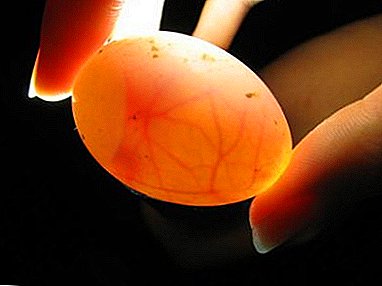
Poultry farmers are specialists who grow and breed chickens, turkeys, and geese. For them, the primary quality of hatching eggs. If you lose sight of something, in the future the chicken will hatch out sick, inactive, unhealthy. In order not to worry about this, ovoscoping of chicken eggs is carried out. This procedure is simple. What does she represent? How and with what frequency to conduct it?
What it is?
Ovoskopirovaniya - a way that allows you to determine the viability of hatching eggs. The poultry farmer shines it for this light beam.
The method exists for a long time. Distant relatives of modern poultry farmers already knew the "power of light" when it was necessary to examine the contents of the egg.
How is it done?
 Before, instead of a special device, an ovoscope was used a candle. Now for reviewing the contents of the eggs will need a device and a special grill. It is placed on the grid, and then shine through by placing the device under it. The method is simple, but it can be used to control the process of incubation development of poultry.
Before, instead of a special device, an ovoscope was used a candle. Now for reviewing the contents of the eggs will need a device and a special grill. It is placed on the grid, and then shine through by placing the device under it. The method is simple, but it can be used to control the process of incubation development of poultry.
If there is no money for a special device, incubation development can be tracked differently. To do this, you will need an ordinary cardboard box and a light source - an incandescent lamp with a capacity of more than one hundred watts.
The reflector is not used by all breeders, but installing it under the lamp also helps. A small hole is made in the box. An egg is placed inside, and it is examined in light turns in different directions.
Process and photo by day
Every day there is no need to conduct overscoping of chicken eggs during incubation. There are reasons for this. What kind?
- If the eggs do not hatch in the incubator, and the chicken incubates them, every inspection for her is stress.
- Damage to the egg.
- Removing the egg from the incubator / removing for some time from the chicken, the temperature drops, and, therefore, development problems may arise (for more information about the storage temperature of the hatching eggs, see here).
For the first time
The first scanning of chicken eggs is carried out on the sixth day of incubation. You can not skip ovoskopatsiya on such a period, since only with its help will be able to determine the degree of fertilization, the state of the circulatory system and the location of the fetus.
In unfertilized eggs, the tone is light, the yolk is a solid dark spot., and there are no rudiments of the circulatory system. If the fetus froze in development, it is large in size, has a pronounced oval shape and an uneven edge.
If there is a blood circle, the germ is dead. If it develops normally, there are no abnormalities, and the circulatory system is clearly visible.
11 day
 After checking on the 6th day, ovoscoping is carried out only on the 11th day. Purpose - assessment of the state of allantois. With proper development, it fits tightly around the contents and closes where the end is pointed.
After checking on the 6th day, ovoscoping is carried out only on the 11th day. Purpose - assessment of the state of allantois. With proper development, it fits tightly around the contents and closes where the end is pointed.
In identifying problems with the development of the circulatory system of allantois, you can help the embryo by improving its nutrition.
18 day
Directly in front of the naklev - on the 18th day they do the ovoscopy for the last time. The procedure is needed to determine the readiness of the fetus for hatching. In the absence of a lumen in the pointed end there are no pathologies.
Procedure for normal development of the embryo
Some poultry farmers do not agree that ovoscoping should be carried out only 3 times. They prefer to do the procedure every three to five days. In the early stages, they weed out unfertilized eggs, looking at the threads of blood vessels.
Poultry specialists can determine the heartbeat by the pinkish hue of the glow. At a later date, Allantois lines the entire inner surface of the shell, closing in one place - at the sharp end.
The normal embryo already has a large shape and the threads of the blood vessels are clearly visible. By the time of hatching, it is even larger, occupies all the internal space and moves.
With pathology
This invaluable diagnostic method allows you to remove eggs from the chicken, the embryos in which develop incorrectly. If too many eggs are rejected, the future should pay attention to the conditions in the incubator.
 Quite often, the embryo is pressed to the shell for a period of 7 days. Its shape resembles a comma. This not normal. Another problem is manifested by pallor of the egg and a weakly pronounced vascular cell.
Quite often, the embryo is pressed to the shell for a period of 7 days. Its shape resembles a comma. This not normal. Another problem is manifested by pallor of the egg and a weakly pronounced vascular cell.
It is advisable before throwing eggs, consult with experts or study the literature on this topic.
What defects can occur during incubation?
- Uneven structure of the shell. It looks spotted or marbled. This defect is manifested due to the fact that there is little or too much calcium in the body of the embryo.
- Light lines - internal damage.
- The presence of air space on the sides, in the middle and in the place of the pointed end.
- Blood clots inside.
- Dark spots are mold.
- Perinki or grains of sand inside the egg.
- Inside there is no yolk, and all liquid has a reddish-orange color. Just broke the yolk, and it mixed with protein.
- Two yolks.
- The "free running" of the yolk or he crouches to the shell.
- Selection and verification rules.
- Incubation mode.
- Shelf life of raw eggs at room temperature.
- How to store?
- The technology of artificial breeding chickens.
- What is the incubation period?
Conclusion
Ovoskopirovaniya - a method that allows to identify problems with the development of the embryo. The poultry farmer will only reveal fertilized and normally developing eggs, and remove the rest. Even a beginner doesn’t have any difficulties with conducting an examination without using a special device - an ovoscope.
Failure to observe the incubation development is fraught with the fact that chicks hatch unviable and sick.












